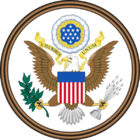Social:No-FEAR Act
This article is missing information about provisions of the law. (November 2014) |
 | |
| Other short titles | Notification and Federal Employee Antidiscrimination and Retaliation Act of 2001 |
|---|---|
| Long title | An Act to require that Federal agencies be accountable for violations of antidiscrimination and whistleblower protection laws, and for other purposes. |
| Nicknames | Notification and Federal Employee Antidiscrimination and Retaliation Act of 2002 |
| Enacted by | the 107th United States Congress |
| Effective | May 15, 2002 |
| Citations | |
| Public law | 107-174 |
| Statutes at Large | 116 Stat. 566 |
| Codification | |
| Acts amended | Civil Rights Act of 1964 |
| Titles amended | 5 U.S.C.: Government Organization and Employees |
| U.S.C. sections amended | 5 U.S.C. ch. 23 § 2301 et seq. |
| Legislative history | |
| |
The Notification and Federal Employee Antidiscrimination and Retaliation Act of 2002 is a United States federal law that seeks to discourage federal managers and supervisors from engaging in unlawful discrimination and retaliation. It is popularly called the No-FEAR Act, and is also known as Public Law 107–174.
Enactment
On August 18, 2000, a federal jury found the US Environmental Protection Agency (EPA) guilty of violating the civil rights of Dr. Marsha Coleman-Adebayo on the basis of race, sex, color and a hostile work environment, under the Civil Rights Act of 1964. She was awarded $600,000. The EPA had refused to promote Coleman-Adebayo shortly after she alleged the presence of environmental and health problems at the Brits, South Africa, vanadium mines.[1]
Sparked by this outcome, Congressman F. James Sensenbrenner, Chairman of the House Judiciary Committee and Texas Congresswoman Sheila Jackson-Lee introduced the No-FEAR Act into Congress. Dr. Coleman-Adebayo founded the No FEAR Institute to organize support for the bill's purposes while continuing to work for the EPA.[1] The No FEAR Institute spearheaded the No FEAR Coalition to advocate for passage of the Act.[citation needed]
President George W. Bush signed it into law on May 15, 2002, making it the first United States civil rights law of the 21st Century.[2]
Criticism
Marsha Coleman-Adebayo and others have criticized implementation of the No-FEAR Act on grounds that agencies are abusing the provision allowing them a "reasonable" time to make their reimbursements to the General Fund of the Treasury. They have proposed a No-FEAR II Act to set a time limit for such reimbursements, and to increase the penalties for violations.[citation needed]
Book and movie
Coleman-Adebayo wrote a book about her experience[3] which (As of 2014) is in the process of being adapted into the movie The Marsha Coleman-Adebayo Story[4] with producer and actor Danny Glover.[1][needs update]
See also
- Civil and political rights
- Civil Rights Movement
- Whistleblower
References
- ↑ 1.0 1.1 1.2 Fears, Darryl (10 July 2006). "Coming Soon: A Tale of Whistle-Blowing at the EPA" (in en-US). Washington Post. ISSN 0190-8286. https://www.washingtonpost.com/wp-dyn/content/article/2006/07/09/AR2006070900741_pf.html.
- ↑ "Discrimination, Whistleblower, and Civil Rights Statutes,"
- ↑ "NO FEAR, THE BOOK - Marsha Coleman-Adebayo". http://www.marshacoleman-adebayo.com/no-fear-the-book.html.
- ↑ "No Fear, the Film". http://www.marshacoleman-adebayo.com/no-fear-the-film.html.
External links
- NOTIFICATION AND FEDERAL EMPLOYEE ANTIDISCRIMINATION AND RETALIATION ACT OF 2002
- No FEAR Coalition web page
- Report of the Department of the Interior
- Report of the FDA
- Reports of the Department of Homeland Security
 |

